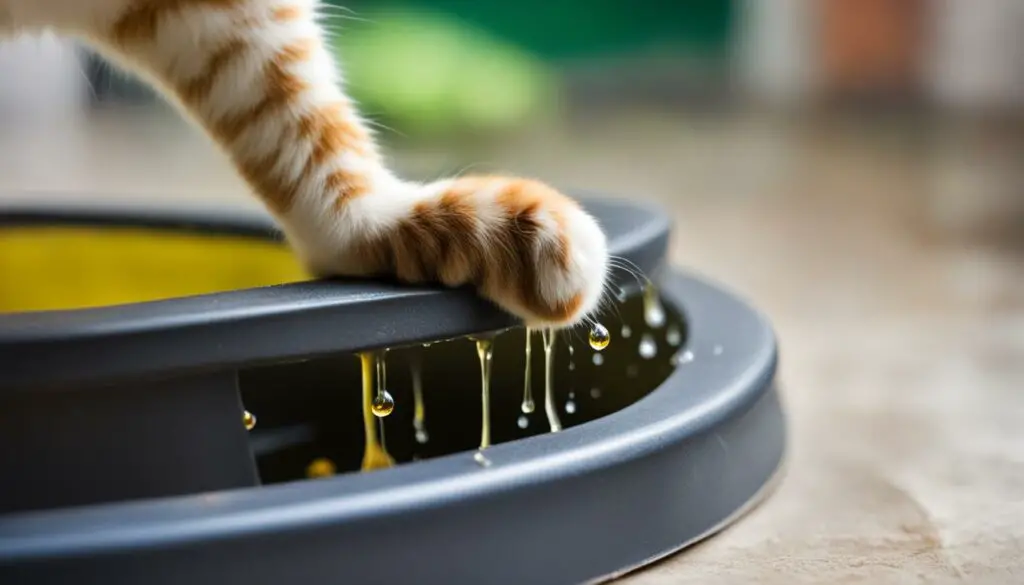Cats may start peeing frequently in small amounts, leading pet owners to wonder what might be causing this change in behavior. Factors such as hydration levels, age, body size, and health status can affect a cat’s urinary habits. It’s important to differentiate between urinating frequently and urinating larger volumes, as these can have different causes and require different medical approaches. It’s crucial to monitor your cat’s urine patterns and seek veterinary attention if there are any noticeable changes, particularly in senior cats.
Key Takeaways:
- Cats may pee frequently in small amounts due to various factors such as hydration levels, age, body size, and health status.
- It’s important to differentiate between frequent small urination and larger volume urination as they can have different causes.
- Monitoring your cat’s urine patterns is crucial, especially in senior cats, and seeking veterinary attention for any noticeable changes.
- Understanding your cat’s normal urinary habits can help identify potential urinary issues.
- Promoting feline urinary health through proper hydration and regular vet check-ups is essential for overall well-being.
How Much Should Cats Pee?
Understanding the normal amount of urine a cat should produce can help pet owners monitor their feline friends’ urinary health. On average, most cats urinate about twice a day. Each urination typically results in clumps of urine that are roughly the size of a golf ball to a tennis ball. These clumps can be observed in the cat’s litter box and serve as a visual indicator of their urinary habits. However, it’s important to note that the amount and frequency of urination can vary depending on various factors such as diet, age, and overall health.
Cats that consume a canned food diet may urinate more frequently compared to those on a dry food diet. Additionally, kittens tend to urinate more often than adult cats. While it’s normal for cats to have some variance in their urine output, senior cats should not urinate more volume or more frequently than adult cats. Any significant changes in a cat’s urinary patterns, especially for senior cats, should be closely monitored and may warrant veterinary attention.
To establish a baseline for comparison, pet owners can track their cat’s urine output over a period of time. This can be done by observing and recording the frequency and clump size of urine in the litter box. By understanding their cat’s normal urine patterns, pet owners can more easily identify any deviations or changes that may require further evaluation by a veterinarian.
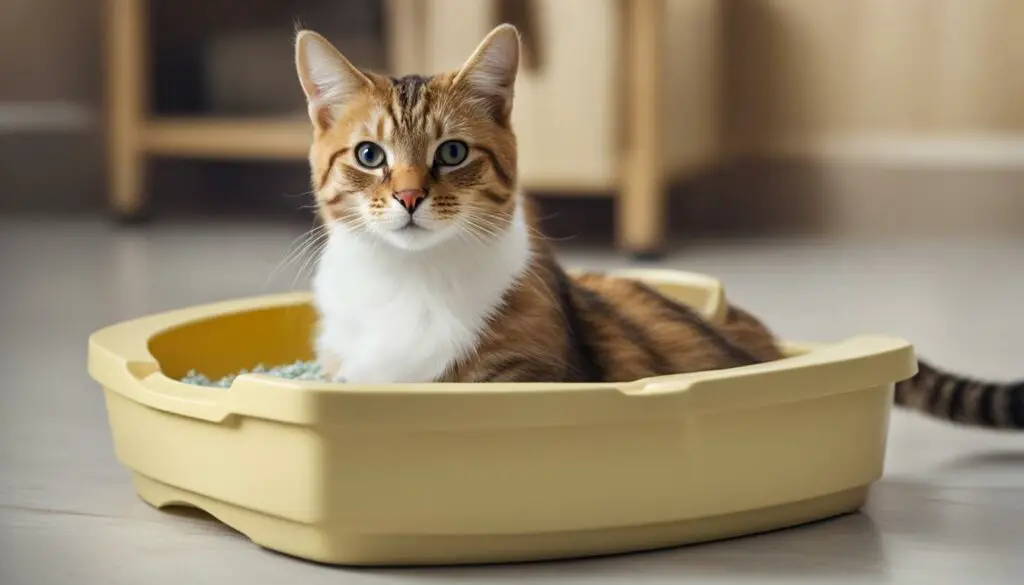
How Much Should Cats Pee?
| Cat’s Age | Frequency of Urination | Approximate Urine Clump Size |
|---|---|---|
| Kittens | More frequent than adult cats | Small clumps |
| Adult Cats | Average of twice per day | Golf ball to tennis ball-sized clumps |
| Senior Cats | Similar frequency to adult cats | Similar clump size to adult cats |
Cats That Are Peeing a Lot vs. Peeing More Often
When it comes to changes in a cat’s urinary habits, it’s important to differentiate between cats that are urinating a large amount of urine and those that are urinating more frequently but in small amounts. These two conditions, known as polyuria and pollakiuria, respectively, have different underlying causes and require different approaches to diagnosis and treatment. Understanding the distinctions between the two can help pet owners better identify and address their cat’s urinary issues.
What is Polyuria?
Polyuria, or excessive urination, is diagnosed when a cat produces more than 50 ml/kg/day of urine. Cats experiencing polyuria often produce larger clumps in the litter box and may exhibit increased water intake. This condition can be caused by various factors, including diabetes, kidney disease, certain medications, or hormonal imbalances. It is essential to consult a veterinarian if your cat is urinating a large volume of urine, as further investigation is needed to identify the underlying cause.
What is Pollakiuria?
Pollakiuria, on the other hand, refers to cats that are urinating more frequently but in small amounts. These cats may visit the litter box multiple times a day and display a higher frequency of urination. Pollakiuria can be caused by conditions such as bladder inflammation, urinary tract infections, or the presence of urinary crystals. If you notice your cat urinating more often than usual but with reduced urine volume, it is important to consult a veterinarian to determine the underlying cause and appropriate treatment.
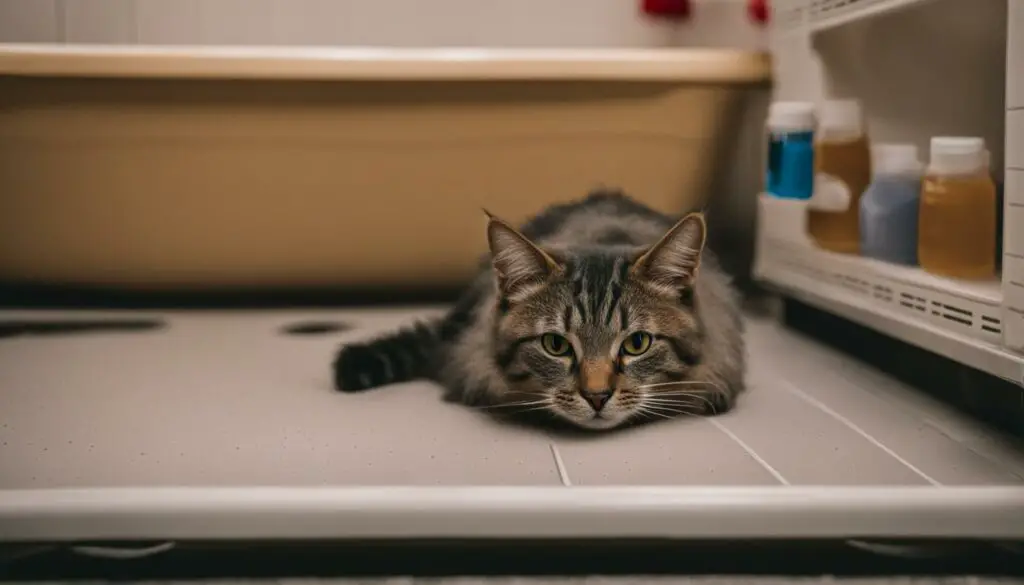
Table: Comparison of Polyuria and Pollakiuria
| Polyuria | Pollakiuria |
|---|---|
| Large volume of urine | Small amounts of urine |
| Produces larger clumps in the litter box | Produces smaller clumps in the litter box |
| May indicate underlying conditions like diabetes, kidney disease, or hormonal imbalances | May indicate conditions such as bladder inflammation, urinary tract infections, or the presence of urinary crystals |
| Requires veterinary attention to identify underlying cause | Requires veterinary attention to determine underlying cause and appropriate treatment |
By understanding the differences between polyuria and pollakiuria, cat owners can play an active role in monitoring their cat’s urinary habits and seeking prompt veterinary attention when necessary. Regular communication with a veterinarian is crucial in diagnosing and addressing urinary issues, ensuring the health and well-being of our feline companions.
Factors That Affect How Much a Cat Pees
Several factors can affect the amount of urine a cat produces. These include hydration levels, diet, and medications.
Hydration levels: Cats that are well-hydrated tend to produce more urine than those that are dehydrated. It’s important to ensure that your cat has access to fresh, clean water at all times.
Diet: The type of food your cat eats can also impact its urine output. Cats on a canned food diet typically produce more urine compared to those on a dry food diet. This is because canned food has a higher moisture content, increasing overall hydration levels.
Medications: Certain medications, such as diuretics, can also affect a cat’s urine production. Diuretics increase urine output by promoting fluid elimination from the body. If your cat is on medication, it’s important to monitor its urine output and consult with your veterinarian if there are any noticeable changes.
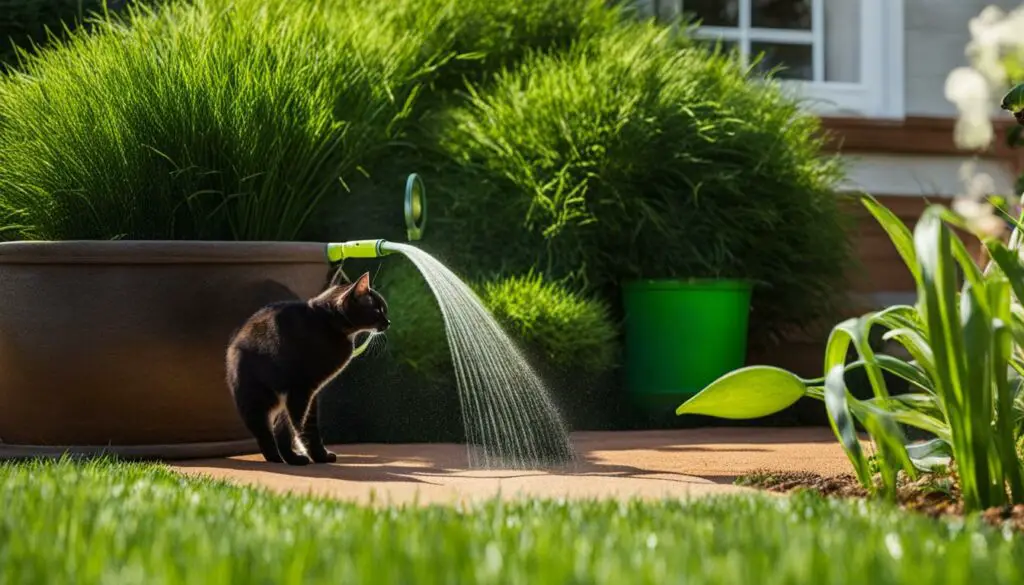
In summary, factors such as hydration levels, diet, and medications can all have an impact on how much urine a cat produces. By ensuring your cat stays properly hydrated, feeding a balanced diet, and monitoring any changes in urine output, you can help maintain your cat’s urinary health.
Reasons Why Your Cat Is Peeing a Lot
Cats may pee a lot due to various reasons, including diabetes, kidney disease, urinary crystals, and urinary infections. These conditions can cause changes in a cat’s urinary habits, leading to increased urine output. Understanding the underlying causes is essential for proper diagnosis and treatment.

Diabetes is a common condition that can affect cats of all ages. It occurs when the cat’s body is unable to regulate blood sugar levels properly. Increased thirst and urination are common symptoms of diabetes in cats. If you notice that your cat is peeing more often and producing larger amounts of urine, it is important to consult with a veterinarian for proper diagnosis and management.
Kidney disease is another common cause of increased urination in cats. It is more prevalent in middle-aged and older cats. Kidney disease can lead to a decrease in kidney function, resulting in an increased production of urine. Other signs of kidney disease include weight loss, decreased appetite, and increased drinking. If you suspect your cat has kidney disease, it is crucial to seek veterinary attention for proper evaluation and treatment.
Urinary crystals and urinary infections are also common causes of increased urination in cats. Urinary crystals can irritate the bladder lining, leading to increased urine production. Urinary infections, on the other hand, can cause inflammation in the urinary tract and also result in increased urination. These conditions can be diagnosed through urine analysis and treated with appropriate medications and dietary management.
It is important to note that increased urination in cats can be a sign of underlying health issues. If you notice any changes in your cat’s urinary habits, such as peeing more frequently or producing larger volumes of urine, it is recommended to consult with a veterinarian for proper evaluation and treatment.
When to See a Vet for Excessive Urination in Cats
If you notice that your cat is urinating excessively, it’s important to schedule a visit to the veterinarian. This applies to both cats that are urinating larger volumes and those that are urinating more frequently but in smaller amounts. Excessive urination can be a sign of an underlying medical condition that needs to be diagnosed and treated by a professional.
However, if you have a male cat and notice signs such as straining to urinate, producing small amounts of urine, or having blood in the urine, it’s considered an emergency situation. These signs may indicate a urinary tract blockage, which can be life-threatening. Immediate veterinary attention is crucial to prevent serious complications and potential fatality.
“Anytime you observe that your cat is urinating a significantly increased amount, it is advisable to schedule a visit to the veterinarian.”
When you visit the vet, they will conduct a thorough examination of your cat to determine the cause of the excessive urination. They may collect a urine sample for analysis and recommend additional diagnostic tests, such as x-rays or bloodwork, to further evaluate the condition. Based on the findings, your veterinarian will develop an appropriate treatment plan to address the underlying cause and restore normal urinary patterns in your cat.
Remember, early detection and intervention are key to ensuring the health and well-being of your cat. If you observe any changes in your cat’s urinary habits, don’t hesitate to seek veterinary attention.
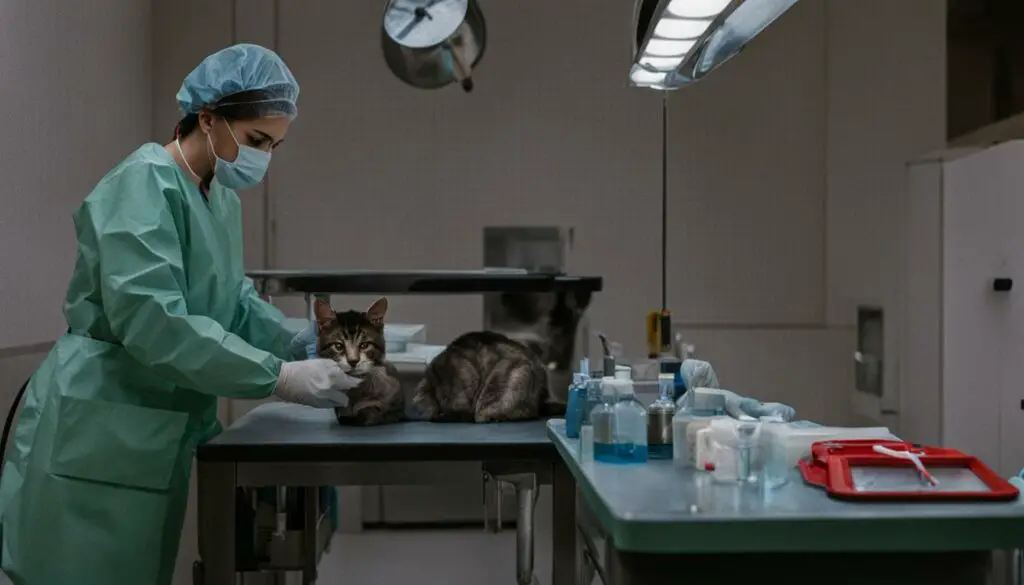
How Vets Diagnose Cats That Pee Frequently
A veterinary examination is crucial in diagnosing the underlying causes of increased urination in cats. The veterinarian will conduct a thorough physical examination, feeling the kidneys and bladder area for any abnormalities. This initial assessment helps determine if there are any palpable masses, enlarged organs, or signs of pain or discomfort.
Collecting a urine sample is an essential part of the diagnostic process. The veterinarian may obtain a urine sample via cystocentesis, which involves using a needle and syringe to collect urine directly from the bladder. Alternatively, they may use non-invasive methods such as free catch or litter box collection. The urine sample can provide valuable information about the cat’s urinary health, including levels of protein, glucose, red and white blood cells, and the presence of bacteria or crystals.
In some cases, additional diagnostic tests may be recommended. X-rays can help identify the presence of bladder stones or other abnormalities in the urinary tract. Ultrasounds can provide detailed images of the kidneys and bladder, helping to evaluate their size, shape, and overall function. Bloodwork can also be valuable in assessing kidney function, checking for signs of infection, and ruling out systemic diseases that may contribute to increased urination.
Table: Diagnostic Tests for Urinary Problems in Cats
| Diagnostic Test | Purpose |
|---|---|
| Physical examination | To assess for palpable abnormalities in the kidneys and bladder area |
| Urine sample collection | To analyze the composition of the urine and detect any abnormalities |
| X-rays | To identify bladder stones or other abnormalities in the urinary tract |
| Ultrasounds | To provide detailed images of the kidneys and bladder |
| Bloodwork | To assess kidney function, check for signs of infection, and rule out systemic diseases |
The combination of physical examination, urine sample analysis, and additional diagnostic tests allows veterinarians to gather comprehensive information about a cat’s urinary health. This information helps determine the underlying cause of increased urination and guides the development of an appropriate treatment plan.
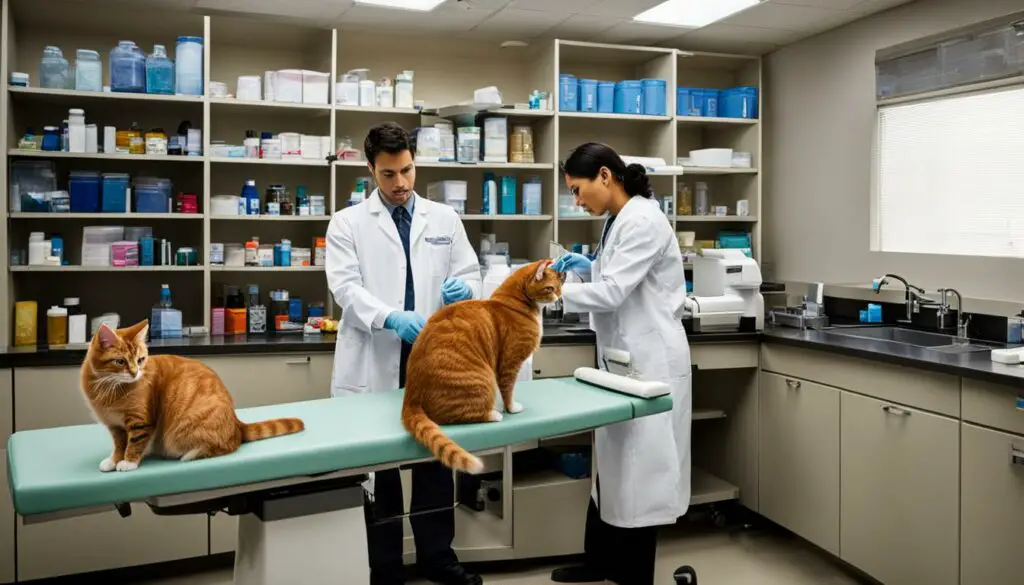
Treatment for Excessive Urination in Cats
When it comes to addressing excessive urination in cats, the treatment approach will depend on the underlying cause and the specific medical history of your feline companion. Here are some common treatment options for increased urination in cats:
1. Diabetic Cat Treatment: If your cat has been diagnosed with diabetes, the primary focus will be on managing blood sugar levels through dietary changes and insulin administration. A high-protein canned food diet is often recommended, as it can help regulate blood sugar levels more effectively than dry food. Insulin injections or oral medications may also be prescribed by your veterinarian to help control your cat’s diabetes.
2. Kidney Disease Treatment in Cats: Treatment for kidney disease in cats aims to slow the progression of the disease and manage its symptoms. This may involve diet modifications, such as switching to a kidney-friendly diet that is low in phosphorus and high in quality protein. Medications to manage blood pressure and control phosphorus levels may also be prescribed. Regular monitoring and supportive care, such as fluid therapy, may be necessary to maintain your cat’s overall well-being.
3. Urinary Crystals Treatment in Cats: When urinary crystals are present, treatment focuses on preventing their formation and promoting their dissolution. This can be achieved through diet changes and the use of prescription urinary tract diets that help acidify the urine and prevent crystal formation. Increasing water intake and providing multiple fresh water sources throughout the house can also help flush out crystals and promote urinary health.
4. Urinary Infection Treatment in Cats: Urinary tract infections in cats are typically treated with a course of antibiotics prescribed by your veterinarian. The specific antibiotic and duration of treatment will depend on the severity and type of infection. It’s important to complete the full course of treatment as prescribed to ensure the infection is completely eradicated and prevent reoccurrence.
Summary:
Treatment for excessive urination in cats depends on the underlying cause. Diabetic cats may require dietary changes and insulin administration, while kidney disease may necessitate diet modifications and supportive care. Urinary crystals can be managed through diet changes and increased water intake, and urinary infections are typically treated with antibiotics. Consulting with your veterinarian is essential for determining the most appropriate treatment plan for your cat’s specific condition.
| Treatment Options for Increased Urination in Cats |
|---|
| Diabetic Cat Treatment |
| Kidney Disease Treatment in Cats |
| Urinary Crystals Treatment in Cats |
| Urinary Infection Treatment in Cats |
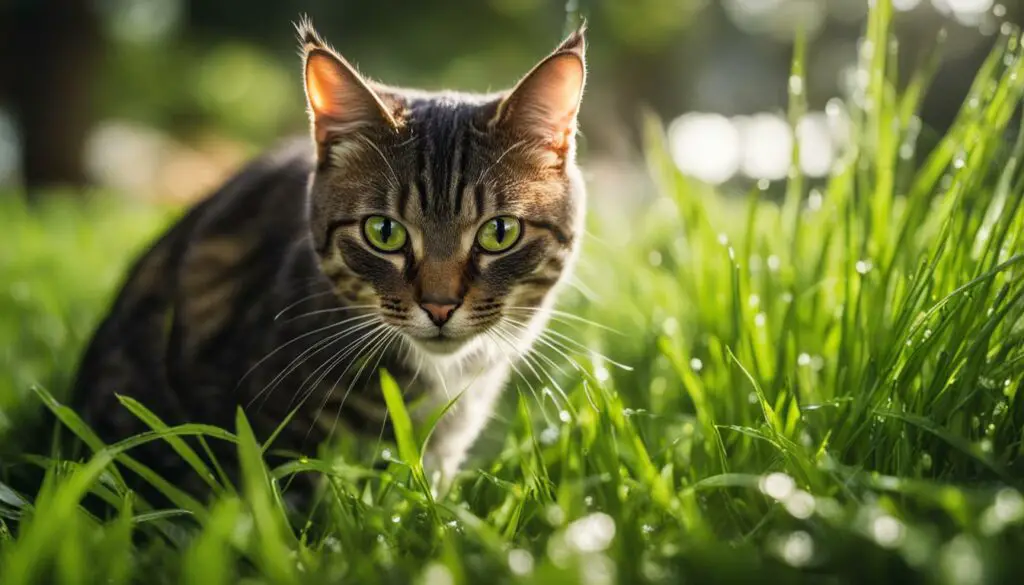
Straining to Pee in Cats – A Sign of Emergency
If you notice that your cat is straining to pee, especially if there is little or no urine output, it is crucial to seek immediate veterinary attention. This could be a sign of a urethral plug, a condition where the urinary tract becomes blocked, preventing the bladder from emptying properly. If left untreated, a blocked cat can quickly become a life-threatening situation. To ensure the health and well-being of your furry friend, it is important to recognize the signs of a blocked cat and seek emergency veterinary care.
Signs that your cat may be blocked include frequent attempts to urinate with little or no urine output, blood-tinged urine, signs of discomfort or pain during urination, increasing lethargy, and excessive licking of the genital area. If you observe any of these symptoms, it is essential to act quickly and contact your veterinarian. Delaying treatment can lead to serious complications, including kidney damage, bladder rupture, or even death.
“If you notice that your cat is straining to pee, especially if there is little or no urine output, it is crucial to seek immediate veterinary attention.”
When you bring your cat to the veterinarian, they will perform a thorough examination to determine the cause of the blockage. This may involve feeling the abdomen for any abnormalities, collecting a urine sample for analysis, and potentially performing additional tests such as x-rays or ultrasounds. The specific treatment for a blocked cat will depend on the severity of the blockage and the underlying cause. Treatment options may include catheterization to relieve the blockage, intravenous fluids to correct dehydration, and medication to alleviate pain and inflammation.
To prevent future episodes of blockage, your veterinarian may recommend dietary changes, such as a prescription urinary diet, to help dissolve any crystals or stones that may be contributing to the problem. Increased water intake can also be beneficial, and your veterinarian may suggest methods to encourage your cat to drink more water, such as using a water fountain or adding water to their food. Regular monitoring of your cat’s urinary habits and seeking veterinary care at the first sign of trouble can help prevent the recurrence of a urethral blockage.
| Signs of a Blocked Cat: | Emergency Veterinary Attention Required: |
|---|---|
| Frequent attempts to urinate with little or no urine output | Yes |
| Blood-tinged urine | Yes |
| Discomfort or pain during urination | Yes |
| Increasing lethargy | Yes |
| Excessive licking of the genital area | Yes |
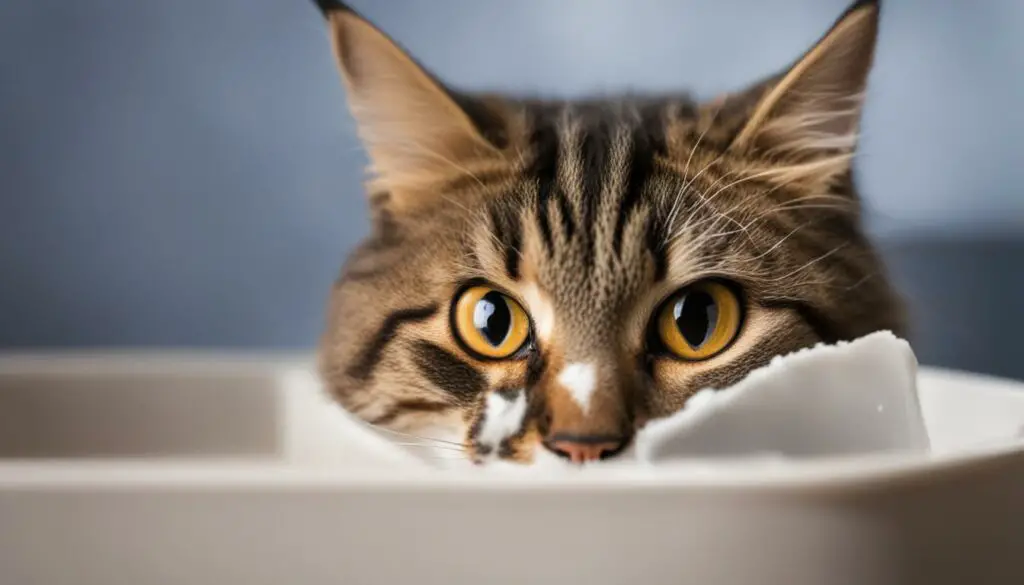
Signs That Your Cat Needs to See a Veterinarian
If you notice any of the following signs in your cat, it is important to seek veterinary attention as these may indicate urinary issues or bladder problems:
- Frequent attempts to urinate with little or no urine output
- Blood-tinged urine
- Vocalization of pain during urination
- Increasing lethargy
- Excessive licking of the genital area
These indicators can be a cause for concern and may suggest conditions such as bladder inflammation, urinary stones, or infections. It is crucial to address these issues promptly to ensure your cat’s health and well-being.
By paying close attention to your cat’s behavior and urinary habits, you can recognize potential problems early on and take the necessary steps to seek veterinary assistance. Your veterinarian will be able to provide a proper diagnosis and recommend the appropriate treatment for your cat’s specific condition.
Remember, early detection and intervention are key in managing and resolving urinary issues in cats. Taking prompt action can help prevent complications and ensure a happier, healthier life for your feline friend.
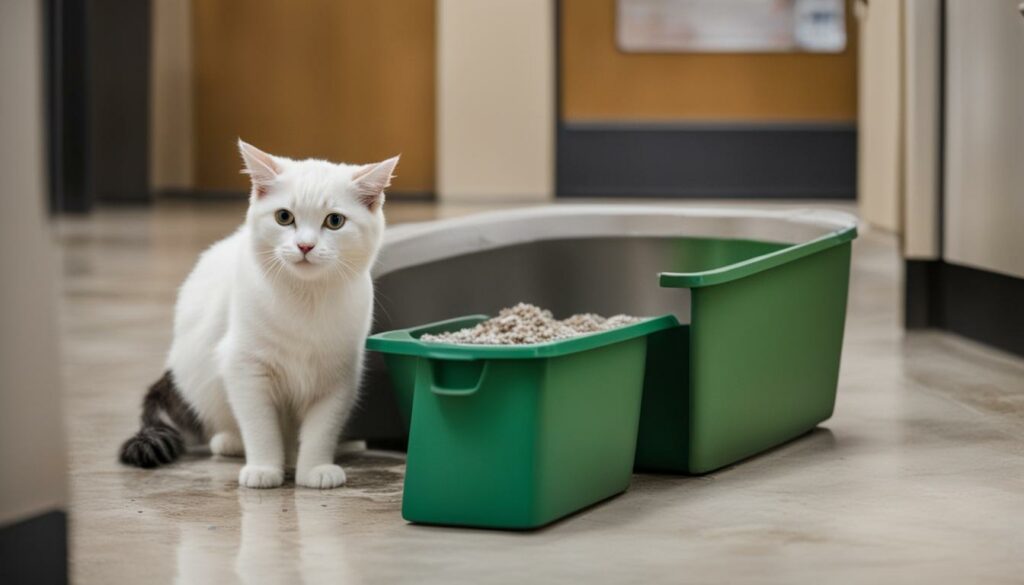
What You Can Do to Help Your Cat
If your cat is experiencing urinary issues, there are several measures you can take at home to provide support and promote their overall urinary health.
Encourage Cat Hydration
One of the most important steps you can take is to ensure that your cat stays properly hydrated. Adequate water intake helps maintain a healthy urinary system and can help prevent certain urinary conditions. Provide multiple sources of fresh water throughout your home, and consider using water fountains or running water from faucets to encourage your cat to drink more. In addition, feeding canned food or adding tuna juice to their diet can help increase their water intake.
Diet Changes for Cats with Urinary Problems
Your cat’s diet plays a crucial role in their urinary health. Consult with your veterinarian about the best diet for your cat’s specific condition. Prescription urinary tract diets are available that can help dissolve certain types of crystals and stones and prevent their formation. These diets are formulated to promote a healthy urinary pH balance and reduce the risk of urinary issues. Additionally, your veterinarian may recommend specific dietary modifications, such as reducing the intake of certain minerals, to help manage your cat’s urinary problem.
Provide a Stress-Free Environment
Stress can contribute to urinary issues in cats. Create a calm and comfortable environment for your cat by providing hiding spaces, scratching posts, and interactive toys. Minimize changes in their routine and surroundings as much as possible. In multi-cat households, ensure that each cat has their own litter box and feeding area to reduce competition and potential stress.
By implementing these measures, you can help support your cat’s urinary health and make them more comfortable. However, it’s important to remember that these steps should supplement, not replace, veterinary care. If your cat is experiencing urinary issues, it is essential to consult with a veterinarian to obtain a proper diagnosis and develop an appropriate treatment plan.
Common Causes of Straining to Pee
Straining to pee, also known as dysuria, in cats can be caused by various factors, including bladder inflammation (cystitis), urinary stones or urethral plugs, and bladder infections. These conditions can lead to discomfort and irritation in the urinary tract, resulting in straining and difficulty urinating. It is essential to identify the underlying cause to provide appropriate treatment and management for the cat’s condition.
Bladder inflammation, or cystitis, is a common cause of straining to pee in cats. It can be triggered by stress, changes in the environment, or diet. In some cases, the exact cause may be unknown. Cats with cystitis may exhibit signs such as frequent trips to the litter box, straining to urinate, and producing small amounts of urine. It is important to consult a veterinarian for proper diagnosis and treatment.
Urinary stones or urethral plugs can also cause straining to pee in cats. These are solid formations that can obstruct the urinary tract, making it difficult for the cat to pass urine. Male cats are more prone to developing urethral plugs, which can result in a complete blockage, requiring immediate veterinary attention. Treatment may involve the surgical removal of bladder stones or the use of catheters to clear the obstruction.
Bladder infections, or urinary tract infections, can cause inflammation and discomfort in the urinary tract, leading to straining to pee in cats. Bacteria entering the urinary system can result in infection, which may cause symptoms such as frequent urination, painful urination, and blood in the urine. Antibiotics are typically prescribed to treat bladder infections in cats and alleviate their symptoms.
It is important to monitor your cat’s urinary behaviors and seek veterinary advice if you notice any signs of straining to pee or changes in their urinary habits. Early detection and treatment can help manage these conditions effectively and improve your cat’s overall well-being.
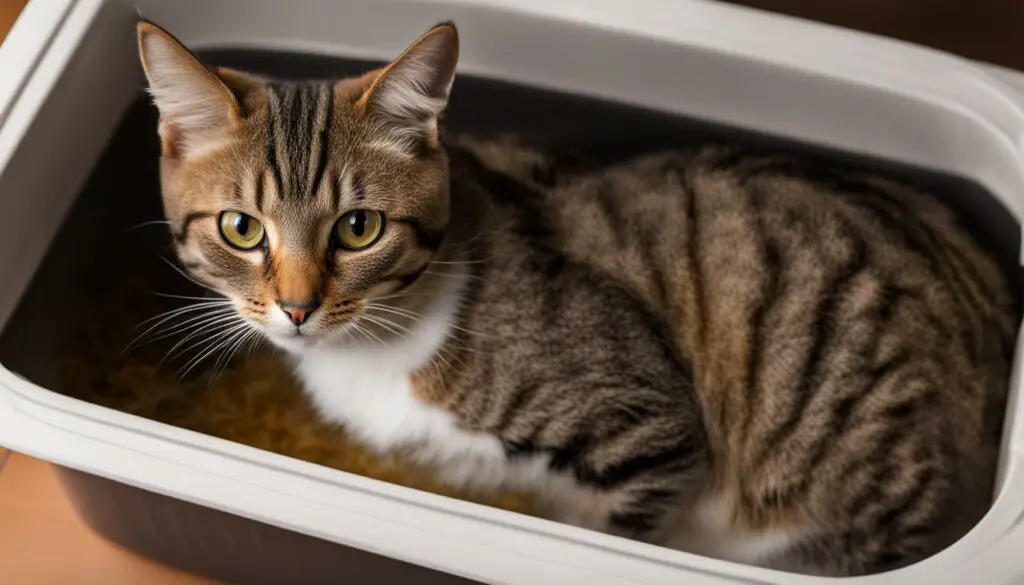
| Causes of Straining to Pee in Cats | Symptoms | Treatment |
|---|---|---|
| Bladder Inflammation (Cystitis) | Frequent trips to the litter box, straining to urinate, producing small amounts of urine | Consult a veterinarian for diagnosis and treatment plan |
| Urinary Stones or Urethral Plugs | Difficulty urinating, obstructed urinary tract, frequent trips to the litter box | Surgical removal of stones or catheterization to clear the blockage |
| Bladder Infections | Frequent urination, painful urination, blood in the urine | Treatment with antibiotics prescribed by a veterinarian |
Treatment Options for Straining to Pee
When it comes to treating cats that are straining to pee, the approach will depend on the specific diagnosis. For cats with bladder infections, antibiotic therapy is commonly prescribed. This helps to eliminate the bacteria causing the infection and alleviate symptoms. It’s important to follow the prescribed dosage and complete the full course of antibiotics to ensure effective treatment.
In cases where bladder stones are the underlying cause, surgical removal may be necessary. The procedure involves removing the stones from the bladder to relieve the obstruction and prevent further discomfort. Your veterinarian will discuss the surgical options available and recommend the best course of action based on the size and location of the stones.
In addition to antibiotics and surgery, other treatment options may include subcutaneous or intravenous fluid therapy to help flush out any grit or debris in the urinary tract. Medications to relax the urethra and reduce inflammation may also be prescribed to alleviate discomfort. Pain medication and anti-inflammatories can provide relief and improve the overall well-being of your cat. Prescription urinary tract diets can help dissolve certain types of crystals and stones and prevent their formation in the future.
| Treatment | Description |
|---|---|
| Antibiotic Therapy | Prescribed to treat bladder infections in cats |
| Surgical Removal | Procedure to remove bladder stones and alleviate obstruction |
| Fluid Therapy | Administered to flush out grit and debris in the urinary tract |
| Medications | Prescribed to relax the urethra and reduce inflammation |
| Pain Medication | Administered to provide comfort and alleviate pain |
| Prescription Urinary Tract Diets | Specialized diets to dissolve crystals and stones and prevent their formation |
The Diagnostic Value of a Litter Box
The litter box is not just a convenient spot for your cat to do their business; it can also provide valuable diagnostic information about their urinary health. By monitoring your cat’s urine habits and observing any changes in their urinary patterns, you can detect potential issues early on and seek timely veterinary attention. It’s important to understand the diagnostic benefits of litter box observation and how it can help you detect changes in urine patterns in cats.
When you regularly check your cat’s litter box, pay attention to the frequency and volume of urine output. Any significant increase or decrease in urine production can be a sign of an underlying problem. Changes in the color, consistency, or smell of the urine can also indicate urinary issues. By observing these changes, you can provide valuable information to your veterinarian, helping them make an accurate diagnosis and develop an appropriate treatment plan.
“Regularly checking your cat’s litter box can provide valuable insights into their urinary health.”
Additionally, monitoring your cat’s litter box can help you determine whether they are straining to pee or experiencing any discomfort during urination. If you notice your cat spending an unusually long time in the litter box or repeatedly visiting it without producing urine, it could be a sign of a urinary tract problem. These observations can prompt you to seek veterinary attention promptly and prevent the condition from worsening.
To effectively monitor your cat’s urine habits, make sure to keep the litter box clean and easily accessible. Use unscented litter, as some cats may be sensitive to strong odors. If you have multiple cats, it’s ideal to provide each cat with their own litter box to facilitate individual monitoring.
| Signs to Monitor in the Litter Box | Potential Indications |
|---|---|
| Increased frequency of urination | Possible urinary tract infection or other urinary issue |
| Decreased frequency of urination | Possible urinary blockage or dehydration |
| Changes in urine color or odor | Possible urinary infection or kidney problem |
| Straining to urinate or spending excessive time in the litter box | Possible urinary blockage or discomfort |
Remember, the litter box can provide valuable insights into your cat’s urinary health. By monitoring their urine habits and being vigilant for any changes, you can take proactive steps to ensure their well-being and seek necessary veterinary care when needed.
Conclusion
Understanding cat urinary issues is crucial for promoting feline urinary health. If you notice changes in your cat’s urination habits, it’s important to seek timely veterinary attention. Pay attention to any frequent urination in small amounts or other signs of discomfort during urination. These could be indicators of urinary tract infections, bladder inflammation, or other underlying conditions.
By monitoring your cat’s urine output and observing any changes, you can take proactive steps to address urinary issues before they escalate. Seeking veterinary advice and diagnosis is key to determining the cause of the problem and developing an appropriate treatment plan.
Promoting feline urinary health involves providing a balanced diet, ensuring hydration, and creating a stress-free environment. Feeding canned food or adding tuna juice to your cat’s diet can increase water intake, which is vital for maintaining a healthy urinary system. Additionally, providing multiple fresh water sources throughout the house and using water fountains can encourage your cat to drink more water.
Remember, your cat’s well-being is in your hands. By understanding cat urinary issues, recognizing changes in urination patterns, and seeking timely veterinary attention, you can ensure that your furry friend leads a healthy and comfortable life.
FAQ
Why is my cat peeing frequently in small amounts?
Cats may start peeing frequently in small amounts due to factors such as hydration levels, age, body size, and health status. It’s important to monitor your cat’s urine patterns and seek veterinary attention if there are any noticeable changes.
How much should cats pee?
Most cats urinate about twice per day, with each urination producing clumps of urine that are typically golf-ball to tennis-ball sized. However, the amount and frequency of urination can vary based on factors such as diet and age.
What is the difference between cats that are peeing a lot and those peeing more often?
Cats that are urinating a large amount of urine and producing larger clumps in the litter box are experiencing polyuria. Cats that are urinating more frequently but in small amounts are said to have pollakiuria. These can have different underlying causes.
What factors can affect how much a cat pees?
Factors such as hydration levels, diet, medications, and certain health conditions can affect a cat’s urine output.
What are some reasons why my cat is peeing a lot?
Common causes of increased urination in cats include diabetes, kidney disease, urinary crystals, and urinary infections.
When should I see a vet for excessive urination in my cat?
It is advisable to schedule a visit to the veterinarian if your cat is urinating a significantly increased amount, regardless of whether it is in larger volumes or more frequently in smaller amounts. It is especially important to seek immediate veterinary attention for male cats displaying signs such as straining to urinate, producing small amounts of urine, or having blood in the urine.
How do vets diagnose cats that pee frequently?
Vets typically start the diagnostic process by conducting a thorough physical examination of your cat and collecting a urine sample. Additional tests such as x-rays, ultrasounds, or bloodwork may be recommended to further evaluate the condition.
What are the treatment options for excessive urination in cats?
The treatment for increased urination depends on the underlying cause and may include dietary changes, medication, surgical removal of stones, antibiotic therapy, or fluid therapy.
Is straining to pee in cats an emergency?
Yes, if your cat strains to pee, especially when there is little or no urine output, it could be a sign of a urinary tract blockage, which requires immediate veterinary attention to prevent serious complications and potential fatality.
What are the signs that my cat needs to see a veterinarian?
Signs that indicate your cat may have urinary issues include frequent attempts to pee with little or no urine output, blood-tinged urine, signs of discomfort or pain during urination, increasing lethargy, and excessive licking of the genital area.
What can I do to help my cat with urinary issues?
You can support your cat by feeding canned food or adding tuna juice to their diet to increase water intake, providing multiple fresh water sources, and using water fountains or running water from faucets to encourage your cat to drink more water.
What are the common causes of straining to pee in cats?
Common causes of straining to pee in cats include bladder inflammation (cystitis), urinary stones or urethral plugs, and bladder infections.
What are the treatment options for straining to pee in cats?
Treatment options depend on the specific diagnosis and may include antibiotics for bladder infections, surgical removal of bladder stones, fluid therapy, medications to relax the urethra and reduce inflammation, and prescription urinary tract diets.
How can the litter box help diagnose urinary issues in cats?
Monitoring your cat’s litter box can provide valuable information about their urinary habits and help detect potential urinary issues. Observing the frequency and volume of urine output, as well as any changes in the appearance of the urine or litter, can be helpful in identifying problems.
Are there any conclusions for understanding cat urinary issues?
Understanding the reasons behind a cat’s frequent urination in small amounts, recognizing potential problems early, and seeking timely veterinary attention are crucial for promoting feline urinary health and ensuring your cat’s overall well-being.

